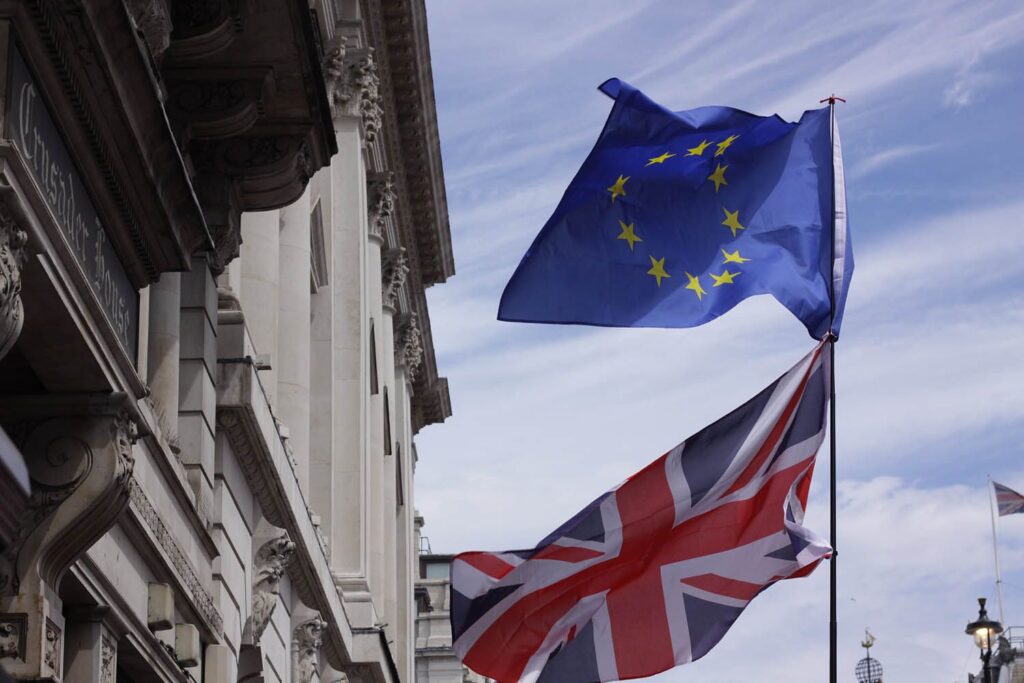UK price growth picked up in December, in line with rising inflation rates in the US and across Europe. The monthly pace of headline CPI was 0.4%, the annual rate edged up to 4% from 3.9% in November. Core data also disappointed the market and failed to fall below 5%, a level it has not reached for 2 years. Instead, annual core price growth stayed steady at 5.1%.
UK beats the French
While this has disappointed analysts, who thought the UK could buck the trend of rising prices at the end of last year, the silver lining is that the UK’s annual CPI rate is finally lower than that of France, for the first time in 2 years!
Could there be good news to come for inflation?
The UK was expected to buck the global trend for inflation growth at the end of last year, however, today’s data shows that the UK is not immune to global price trends. But, like the US, UK producer prices also fell sharply in December. Monthly output prices fell by 0.6% last month, and annual input prices declined at a 2.8% annual rate. Producer prices are at the top of the inflation pipeline, so if they are declining, this can be good news for the direction of consumer prices in the future.
Fags and booze weigh on UK CPI
Digging a bit deeper into the data shows that the largest upward contribution for CPI came from alcohol and tobacco prices. There was some good news in this data set, the largest downward contribution came from food and non-alcoholic beverages. The recent trading updates from the supermarkets attributed some of their stellar sales growth to falling food prices, so this was expected. Added to this, owner occupier housing costs, which have had a big upward impact on inflation in recent years, have stabilized. The annual rate remained steady at 5.3% in December, the same rate as in November. Not so encouragingly, the monthly rate for owner occupiers housing costs rose by 0.4% in December, the same rate of growth as December 2023, most likely driven by rental costs as mortgage rates have fallen substantially.
Service price inflation continues to drive price growth
Other areas of price growth included clothing and footwear, furniture and household goods. Restaurants and hotels saw price growth slow to a 0.5% monthly rate in December, vs a 0.9% monthly growth rate in November. Goods price inflation was flat on the month, the annual rate is 1.9%. Service sector inflation, which has been stickier than goods price growth, grew by 0.7% last month, and the annual rate was 6%, according to the ONS.
Food prices a bright spot, but airfares fly high
Food prices were a bright spot in this report, with the lowest annual growth rate for milk, cheese and eggs since October 2021. Secondhand car prices also fell for the seventh consecutive month and transport costs were also lower, although the pace of the slowdown declined mainly due to upward pressure from air fares. The price of air fares rose by 57.1% in 2023, this was lower than the 61.1% recorded a year ago, but it is good reminder that the era of cheap air travel is over.
Why Red Sea issues aren’t a cause for panic, yet
Petrol prices also fell 8.2p per litre between November and December last year, bringing the annual rate of decline for petrol prices to 10.8%. The risk is that petrol prices will start to rise as a result of the geopolitical tensions in the Red Sea. Shell is the latest oil company to say that it will re-route its tankers away from the Red Sea due to the risk of being hit by a missile. However, even though events in the Red Sea are serious from a geopolitical standpoint, the effects on the economy could be less severe. The oil price has failed to move significantly higher on the back of the Houthis attacks, and Brent crude is currently below $78 per barrel. Added to this, some ships are still sailing through the Red Sea, and a re-route around the horn of Africa adds approx. 9 days to a tanker’s journey to the West. This is not disastrous for the shipping industry, or for the price of consumer goods, in our view. We do not think that the global economy will face the same level of supply disruption as it did during the pandemic, and for now the markets are not in panic mode, for good reason.
Market reaction to UK CPI
The 2-year Gilt yield rose by 4 basis points on the back of the stronger CPI data, continuing the trend for higher yields since the start of January. Market expectations for interest rates have been scaled back this week, and there are now just under 5 interest rate cuts priced in for the UK economy between May and the end of 2024. If the trend in rising prices continues, then we could see rate cut expectations scaled back even further.
The pound jumped on the back of CPI data, and GBP/USD has snapped its losing streak so far this week. $1.2650 is the short-term resistance level that this pair is targeting. If it gets above this level, then it opens the door to a move back towards $1.27.
The speak of the week
Elsewhere, there appears to be coordinated central bank speak pushing back on the notion that interest rates could be cut in early spring. A plethora of ECB speakers have come out in recent days and said that cuts are coming, but they are more likely to come in the summer. The market is now expecting the first rate cut from the ECB to come in April, and it has already priced out some cuts for later this year. The market now expects just over 5 curs from the ECB this year.
Fed speak knocks chances of a March rate cut
In the US, the Fed’s Waller gently pushed back on the market’s expectations for Fed rate cuts, but the market still thinks there is a chance that the first Fed rate cut could come in March, however, expectations have been scaled back considerably. There is now a 61% probability compared with a 77% chance last week. The market is now expecting just over 6 rate cuts in the next 12 months. This readjustment in interest rate expectations has sent volatility higher and stocks are eroding gains that they made last week.
Asia stock market sell off could hurt sentiment in Europe
E mini futures are pointing to a lower open for US stocks on Wednesday, as the market digests the central bank speak this week. Asian stocks are lower across the board and the Nikkei’s hopes to breach the record high from 1989 have been dashed, as Japan’s main index backs away from recent highs. A stock market sell off in Asia deepened on Wednesday as China’s 2023 GDP increased fears about its economy, and the prospect of a slower pace of Fed rate cuts hurt sentiment. The Hang Seng fell nearly 4%, while the China Composite index was down more than 2%.
China growth huts target, but dangers continue to lurk
China’s GDP expanded by 5.2% in 2023, in line with official forecasts, however GDP does not tell the whole story about an economy and while the macro picture looks resilient, there are still major issues with the property sector, which seems to have an unending cycle of problems. Property investment declined by 9.6% YoY last year, and it’s facing its longest period of quarterly deflation since the Asian financial crisis 3 decades ago. China may have hit official growth targets, but it is still an economy under pressure. Its population is declining at a rapid rate, there were more than 2 million fewer people in China last year. This is leading to fears that China is experiencing a structural slowdown, which could have ramifications for the global economy in the coming years.
BP: An uninspired choice for CEO
One final point on BP its announced that its interim CEO Murray Auchincloss, will become its permanent CEO after the Bernard Loney scandal. This is an uninspired choice in our view, and is unlikely to have an impact on the stock price.







